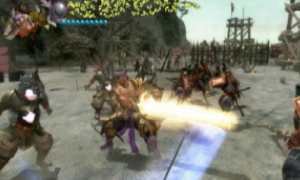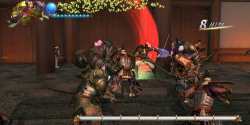Genji
offers players a hack and slash adventure through feudal Japan with plenty
of battles and enemies. The gameplay lets you switch characters, engage in
massive battles and use many types of swords to attack in massive combos.
As in the first Genji, there's a slow-motion mode called Kamui where you
can battle foes with near impunity. This is cool at first, but quickly
becomes gimmicky and distracting. The production values are superbly
detailed, but this cinematic approach involves locked camera angles that
makes the game needlessly frustrating. Genji's gimmicks aren't enough to
cover its flaws and this title's poor execution makes for a frustratingly
difficult and ultimately disappointing experience.
Many players probably won't remember the
first Genji title that came out for the PS2 a few years ago. That was a
somewhat interesting title that had some cool ideas, but suffered from
some pretty major flaws and disappeared from most players' memories
quickly. However, the series has now been resurrected for the Playstation
3 launch, though with disappointing results. The new game takes up after
the original game, and once again follows the adventures of Yoshitsune
Minamoto and his sidekick Benkei Mushashiro, two samurai in 11th century
Japan who are once again battling the evil Heishi forces to restore the
good name of their Genji clan. Their adventure revolves around mystical
jewels called Amahgane, which give anyone who holds them mystical super
powers. Along the way, you'll also be able to play as other characters,
which makes things more diverse. As in the previous game, players can
switch between characters at any point in the game. To help keep things at
least a little bit interesting, each character can unleash a unique
fighting style and brings a different strategy to the action. Knowing when
to switch between them can make a big difference, though not as much as
you would hope.
 Yoshitsune
is a younger, more agile fighter who attacks quickly with his swords.
Benkei's a much larger character, and his movements are slower but he has
a powerful, massive club that he can use to pulverize enemies. The Heishi
forces attack in massive waves and usually surround the player. You can
use a variety of moves to evade their attack and then spin around and
unleash devastating combos to wipe them out. While you're initially given
only a few weapons, your character will gain additional weapons that you
can use. The game allows you to change weapons quickly using the shift
buttons, which can come in quite handy. Using these standard attacks and
implementing combos is fairly straightforward with most of these requiring
only a single button press. Movement is controlled using the analog
sticks, which makes combat fairly simple. Genji's gameplay is fairly good
for a fighting title, and some of the combos offer a satisfying amount of
power. The game's initial stages are fairly straightforward and don't
require much thought. You defeat enemies, unlock chests for bonus items
and progress through magically sealed doors when you find orbs and keys to
unlock them.
Yoshitsune
is a younger, more agile fighter who attacks quickly with his swords.
Benkei's a much larger character, and his movements are slower but he has
a powerful, massive club that he can use to pulverize enemies. The Heishi
forces attack in massive waves and usually surround the player. You can
use a variety of moves to evade their attack and then spin around and
unleash devastating combos to wipe them out. While you're initially given
only a few weapons, your character will gain additional weapons that you
can use. The game allows you to change weapons quickly using the shift
buttons, which can come in quite handy. Using these standard attacks and
implementing combos is fairly straightforward with most of these requiring
only a single button press. Movement is controlled using the analog
sticks, which makes combat fairly simple. Genji's gameplay is fairly good
for a fighting title, and some of the combos offer a satisfying amount of
power. The game's initial stages are fairly straightforward and don't
require much thought. You defeat enemies, unlock chests for bonus items
and progress through magically sealed doors when you find orbs and keys to
unlock them.
Genji seems rather pedantic on the
surface, but the basic combat and fighting is solid, with some minor role
playing elements thrown in. In what is probably the game's most
interesting aspect, you can switch to Kamui mode when your power-bar is
filled up. This works very much like it did in the first game. After Kamui
is enabled, your character enters transported to a different dimension.
The action switches to slow motion, and you're nearby enemies are also
sucked into this area. You can then use your Kamui powers to attack them
before they respond, using context-sensitive commands, usually a single
button press at a prompt. If you defeat them in this mode, they'll
disappear when you return but won't fall if you miss your prompt. It's an
interesting idea and gives Genji a somewhat unique feel, but its
simplicity makes it feel somewhat like a gimmick after the first few
times. Still these are merely distractions, and the main portions of the
game consist of standard combat.
You'll spend a lot of time battling
waves of mindless unimaginative foes, most of which offer little in the
way of resistance. You can slice through them easily, but it takes almost
no effort which makes for a less than satisfying experience. There's a lot
of button mashing, which makes the gameplay feel superficial, shallow and
generally uninteresting. While you can use combos at certain points, there
never really seems to be a need to, unless you want to show off. While the
controls and play mechanics are decent, problems begin to emerge quickly
and only grow more pronounced as you play the game. The first thing you'll
notice is that the enemies will frequently attack from angles where they
aren't on the screen. Since you can't manually adjust the camera angle,
you're basically fighting in the dark and need to move away and hope to
draw them into your line of sight. This makes combat sequences far more
frustrating than they could have been. While you can auto-target, it's not
nearly as effective as it could have been and makes you take damage you
really wouldn't have.
 While
your first impressions of the game are probably going to be impressive,
things begin to fall apart once you delve deeper. Genji's production
values are superb with richly detailed environments, fantastic character
animation and brilliant special effects such as fire and water that bring
the world to life vividly. From an aesthetic standpoint, you can
definitely see the PS3's power in evidence. Elaborate voice acting and an
interesting storyline unfold as well, and brings the world to life.
Unfortunately, all of this effort has gone into what are basically
pre-rendered backgrounds with some interactive objects thrown in. The
fixed camera changes angles frequently and without warning. This is
disorienting and makes it hard to figure out what direction to go in.
There's an onscreen map, but this actually makes the game even more
confusing than it should be. Some of the gameplay elements, such as the
numerous crate smashing and simplistic puzzles seem to lack imagination
and make the game feel quite outdated.
While
your first impressions of the game are probably going to be impressive,
things begin to fall apart once you delve deeper. Genji's production
values are superb with richly detailed environments, fantastic character
animation and brilliant special effects such as fire and water that bring
the world to life vividly. From an aesthetic standpoint, you can
definitely see the PS3's power in evidence. Elaborate voice acting and an
interesting storyline unfold as well, and brings the world to life.
Unfortunately, all of this effort has gone into what are basically
pre-rendered backgrounds with some interactive objects thrown in. The
fixed camera changes angles frequently and without warning. This is
disorienting and makes it hard to figure out what direction to go in.
There's an onscreen map, but this actually makes the game even more
confusing than it should be. Some of the gameplay elements, such as the
numerous crate smashing and simplistic puzzles seem to lack imagination
and make the game feel quite outdated.
What's really disappointing about
Genji's next generation debut comes in the realization that these problems
were very much evident in the PS2 edition. The developers have seemingly
made no effort to fix them here - the basic structure and premise are
largely unchanged. As mentioned earlier, the fixed camera angles allow for
a more cinematic approach, but they undermine the gameplay, making you
feel like you're barely interacting with a movie, not playing a game. This
approach makes targeting enemies and level progression particularly
frustrating and the execution makes Genji needlessly complex. You'll waste
a lot of time backtracking and going around in circles which makes Genji
much more frustrating than it should have been. Despite some cool ideas
and the lavish production values, Genji: Days of the Blade is a
frustratingly lazy game that feels like it could have been done on the PS2
with little change in quality. Its unimaginative gameplay is predictable
and dull, while the static backgrounds and level designs never make you
feel connected to the action onscreen. In the end, Genji is a
disappointing sequel that makes for a sub-par launch title. Despite its
visual polish, it fails to deliver on the potential of next-generation
gaming and barely makes an effort to improve on the structural faults that
marred Genji's first installment.
- Michael Palisano
Grade: C-

